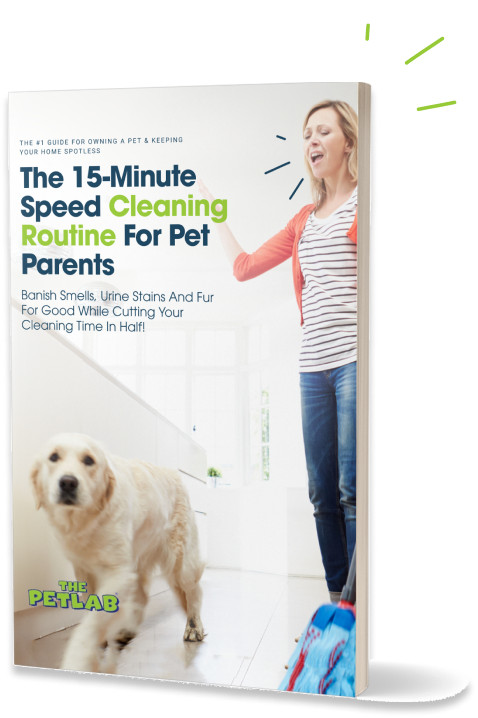Housetraining a dog will have you riding a roller coaster of emotions. Annoyance, frustration, glee, pride—and not always in that order.
Because, as the popular puppy meme goes, the lovely new addition to your family will pee on the things you love.

Think shoes, furniture, carpets, and your prized hardwood floors. 😑
Sigh… Turns out, bringing a puppy home isn’t all rainbows and butterflies. There’s pee and poop, too. 💩 Plenty of it!
Unless you know how to train a puppy not to pee in the house.
Keep calm, guys. We’ve got you covered with our top 5 tips to toilet-train your dog.
These dos and don’ts work on all breeds and can also be used for potty training older dogs.
The dog parent’s guide to puppy toilet training
Here’s how to toilet-train your dog the right way.
1. Go for regular toilet breaks.
Fun fact: Dogs don’t have maximum bladder control until 12 months old.
Find yourself wondering, how many potty breaks does a puppy need? The answer is a lot. The younger the puppy, the more often he has to go potty.
Between 6 and 14 weeks old, your pupper will most likely go 8 to 10 times daily. By 30 weeks and up, the need to urinate is reduced to 3 to 4 times. Phew! 😮💨
The rule of thumb is the puppy's age in months + 1 = how long he can hold it in. At most! Longer than that, evacuation becomes urgent.

2. Stick to a schedule.
Fun fact: Dogs need a routine.
Like their humans, dogs are creatures of habit. So, knowing what to expect helps keep your pet’s stress level low.
Good news for you since a bad case of nerves can trigger anxiety pooping in puppies and older dogs adjusting to a new routine.
Either way, no, thank you! 🤢 That’s why the key to successful puppy toilet training is consistency.
When is the best time to take your puppy out to eliminate? Here's a sample puppy potty training schedule:
- First thing in the morning
- After your puppy’s breakfast
- After morning playtime
- Every 30 to 60 minutes throughout the rest of the day (adjusting for age)
- Every time your puppy wakes up from a nap
- After afternoon playtime
- After your puppy’s dinner
- Before bedtime
P.S. Laziness and bad weather are no excuses to break your routine. Wee and poo don’t wait for the sun to shine. 😉

3. Keep an eye on your puppy at all times.
Fun fact: Dogs have a natural instinct not to soil where they eat or sleep.
Sounds good on paper, right? But the truth is, your puppy will find another room (or that perfect spot behind your couch) to do his business.
What is the solution?
Supervise your dog during the puppy toilet training period. This has two benefits: First, you will get to know your dog’s potty-signalling mannerisms.
Second, there is no opportunity for him to “let it go” where he's not supposed to.
You're teaching your dog that there's a place for urination/pooing—and it's not indoors. Yay for being proactive! 👏
Common tell-tale signs your pup has gotta go:
- Scratching
- Pacing
- Barking (or whimpering)
- Sniffing and circling one spot
- Preparing to squat
- Wandering out of sight

4. Reward proper behaviour.
Fun fact: Housebreaking a dog can take up to a year.
That’s right. Puppy toilet training doesn’t happen overnight. But punishing your pet for going in the wrong place will not speed up the process either.
If anything, you could end up doing more harm than good.
😟 Shouting, scolding, spanking, and rubbing your puppy's nose in pee or poo = scary. (So is chasing him with a folded newspaper!)
Positive reinforcement works wonders, though. Every time your good boy gets things right, reward him immediately.
Rewards can be praises, rubs, tasty treats, access to his favourite toys—or a combination of these.

5. Do a good job cleaning up.
Fun fact: Dogs are attracted to the smell of urine.
Why do dogs pee in the same spot, you ask? Because they smell traces of urine/faeces there, which makes that spot fair game for toilet business... 😬
That's why cleaning up is a crucial part of puppy toilet training. Fortunately, removing pet odours is easy when you have an enzymatic cleaner.
Compared to standard cleaning products, the good bacteria in enzyme-based cleaners permanently rid surfaces of pet-related odours.
They do this by breaking down (and then consuming) molecules in organic matter like pee, poop, and pet vomit.
It's just what you need when housebreaking a puppy: Deep cleaning without extra effort!

Eliminate urine stains & odours permanently with the PetLab Stain & Odour Remover
Have a puppy toilet training tip that will help others? Share it with fellow pet parents in the comments below.


